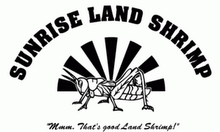 Giant Water Bugs [Lethocerus indicus, which for some reason I've barely mentioned in this blog]. I call them 'usual' because they're one of the insects more-or-less easily available in Asian markets in Providence. Though I've seen them served whole-fried in Thailand (I found myself unable to masticate them much at all, I guess my mouth is too tender), I serve them filleted; taking out the muscle tissue in the thorax. Most people are pretty blown away by the taste of it, but some folks just purely hate it.
Giant Water Bugs [Lethocerus indicus, which for some reason I've barely mentioned in this blog]. I call them 'usual' because they're one of the insects more-or-less easily available in Asian markets in Providence. Though I've seen them served whole-fried in Thailand (I found myself unable to masticate them much at all, I guess my mouth is too tender), I serve them filleted; taking out the muscle tissue in the thorax. Most people are pretty blown away by the taste of it, but some folks just purely hate it.and the unusual:

Thorny Stick Insects [Eurycantha horridum], which unfortunately are not all that good after all. Not much to eat on them, but they're much appreciated and enjoyed in Papua New Guinea, where they're stuck on a stick and roasted over the fire.
And there was one item that I myself had never tried: house fly pupae.
I'd gotten them last fall, through the kindness of folks at Cornell's Ag department -- thanks again, Allie!! I can admit now that I had a bit of a hang up about trying them, which had surprised and disappointed me. After all, I was supposed to be beyond having such issues. The problem I had was that when I picked them up in the insectary, I smelled what they'd been eating -- a mixture of milk and really rich calf feed, I think -- and saw the dried bits of that mixture among the pupae; I didn't enjoy the prospect of separating them.
 Between the smell and the prospect of having to sort through the pupae themselves [the tiny red pills] and fish out the bits of their food [the vague nuggets], I wasn't eager. But at last I realized the simple solution there in front of me all along. If I would just parboil the pupae, as I did the crickets as part of their processing, the nuggets would melt away; such smell as there might be would dissipate as well; and then I could pan-fry the pupae and serve.
Between the smell and the prospect of having to sort through the pupae themselves [the tiny red pills] and fish out the bits of their food [the vague nuggets], I wasn't eager. But at last I realized the simple solution there in front of me all along. If I would just parboil the pupae, as I did the crickets as part of their processing, the nuggets would melt away; such smell as there might be would dissipate as well; and then I could pan-fry the pupae and serve.And it worked fine! Unfortunately I was too distracted to get an image of the final result, so once again my patient readers will have to take my word for it -- until such time, at least, as they can sample such cuisine for themselves. The pupae have a little bit of crunch from the very thin shells. The flavor is rich with a hint of iron, sort of like blood pudding. All other things being equal (meaning, if the idea of it wasn't particularly disgusting to so many people) I think there could be great potential for mass-rearing them and processing the pupae into either a flour or "hamburger helper" kind of protein ingredient.
I'm very happy to have gotten over my hang-up about this food. As always, I'm not describing all of this to gross anyone out. It's a food like any other, it wasn't raised on dead meat or on the side of the road, and therefore it's just like any other kind of entomophagy: a matter of triumphing over that bad ol' cultural conditioning.
